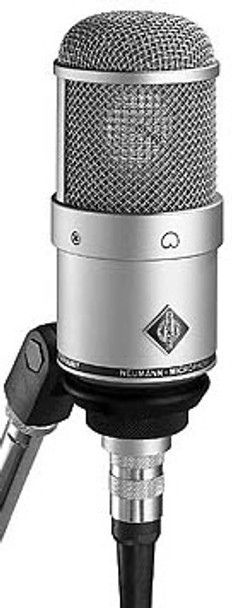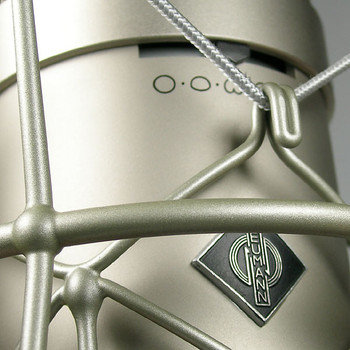Description
The M 147 Tube is a vacuum tube condenser microphone with cardioid characteristic. At the heart of this microphone is the K 47 dual diaphragm capsule, inherited from this model's now legendary predecessors, the U 47 and the M 49.
Following the capsule is a tube that functions as an impedance converter. The next stage is an efficient, transformerless output circuit, that guarantees an extremely low self-noise level. Note: This innovative combination of current tube technology with the most advanced solid-state circuitry was decisive in awarding the 1997 TEC Award to the related M 149 Tube mic.
The M 147 Tube can feed extremely long microphone cables without affecting the quality of the audio signal. Like all Neumann tube microphones, the M 147 Tube comes with an elegant satin Nickel finish.
The microphone is delivered as a complete set in a high-quality aluminum case. Included with the microphone are a microphone cable, a metal swivel mount for a mic stand, and a compact universal power supply for standard mains sockets. Our modern manufacturing methods makes it possible to offer this complete set at a very attractive price.
Features
- Universal tube microphone
- Pressure gradient transducer with the large diaphragm capsule from the legendary U 47 and M 49
- Transformerless circuitry
- Low self noise level
- Comes with swivel stand mount made of metal, universal power supply, and cable in an attractive aluminium case
Applications
The famous capsule, together with complimenting tube characteristics, makes the M 147 Tube especially well suited as a vocal mic. In addition, it is a superb spot mic for all types of musical instruments. The extremely low self-noise of its tube circuitry makes the mic perfectly suited for use in modern recording chains, analog and digital.
- Vocalist mic: its warm and yet transparent sound gives volume and presence
- Announcer's mic for broadcasting dubbing, and voice-over
- Spot mic for close miking of solo instruments, especially strings, wind instruments, piano
Acoustic features
The M 147 Tube is addressed from the side, where the microphone body has the diamond-shaped Neumann company logo. The black color identifies tube microphones. The capsule is equivalent to the one used in the U 47, and is the deciding factor in determining the sound characteristic. It has a flat frequency response to the upper midrange, and a boost of up to 3 dB above 2 kHz. The headgrille design is a smaller version of the U 47. It protects the capsule effectively against popping and wind noise.
Polar pattern
The M147 Tube has a cardioid characteristic, leaning more toward super-cardioid due to its distinctive capsule design. At higher frequencies the pattern becomes more directional. This is very similar to the model after which this new tube microphone was patterned, the U 47 and the successor, the U 47 fet.
Electrical features
When compared to other microphones, the impedance converter used in the M 147 Tube is distinguished by its extremely low self-noise level of only 12 dB-A / 24 dB CCIR weighted.
Similar to the recently introduced M 149 Tube, the new M 147 Tube combines a specifically selected vacuum tube (triode) with modern circuitry. This technique takes full advantage of the special transfer characteristics of the tube and passes the processed audio signal of the capsule to the microphone output, without any coloration or unwanted side effects.
The tube amplifies the capsule's signal by approximately 10 dB, thus preventing any possible influences from subsequent electronics. The M 147 Tube delivers a high output voltage, and therefore can feed microphone cables up to 300 m length without signal degradation.
The ideal operating conditions (anode current, heater voltage) of the tube are maintained throughout its life expectancy. A sensor lead detects any voltage drop that occurs through the microphone cable and compensates for it in the N 149 A power supply. The tube warms up gradually using inverse current limiting to guarantee long life.
Filter
The electronic circuitry of the M 147 Tube mic has a flat frequency response from 20 Hz to well above 20 kHz. Only the attributes of the capsule determine the typical sound characteristics of the microphone.
Operational Stability
Both, the capsule and the entire circuitry are shock mounted to prevent any structure-borne noise. Because of its wide operating range, the M 147 Tube can reproduce extremely low frequency signals without distortion.
This implies that the microphone may also be sensitive to unwanted LF interference by structure-borne noise, or wind noise. To avoid possible signal degradation, we offer the EA 1 elastic suspension and the WS 87 windscreen as accessories. During close miking of vocals we recommend using the PS 15 or PS 20a pop screen.
N 149 A Power Supply
The N 149 A power supply generates the necessary operating voltages for M 147 Tube, M 149 Tube or M150 Tube microphones. It operates with all mains voltages from 100 V to 240 V, 50 or 60 Hz. Mains power is connected through a standard IEC 320 socket. The microphone connects via an DIN-8 connector.
The microphone signal is fed to a XLR 3 M connector. The modulation output is balanced. The N 149 A supplies the bias voltages for the microphone capsule, the filament voltage controlled by a sensor circuit, and a further voltage to generate the plate voltage and other necessary operating voltages within the microphone itself.
The unit produces constant current effecting a soft start of the tube. The KT 8 cable between microphone and power supply can be up to 100 m long. Modulation cable lengths up to approx. 300 m are allowed.
KT 8 Microphone Cable
Cable with double twist (double helix) braiding as shield. Diameter 5 mm, length 10 m. DIN 8 connectors. Other cable lengths are available upon request! Cable material without connectors are also available. Even if very long (Neumann) cables are used, the electroacoustic characteristics of the microphone are not affected.Only with cable lengths well over 300 m a high-frequency roll-off is noticeable.
Specifications
Directional pattern Cardioid
Frequency range 20 Hz ... 20 kHz
Sensitivity at 1 kHz into 1 kohm 20 mV/Pa
Rated impedance 50 ohms
Rated load impedance 1 kohms
Equivalent noise level, CCIR1) 24 dB
Equivalent noise level, A-weighted1) 12 dB-A
Signal-to-noise ratio, CCIR1) (rel. 94 dB SPL) 70 dB
Signal-to-noise ratio, A-weighted1) (rel. 94 dB SPL) 82 dB
Typical SPL (tube characteristic)2) 114 dB for THD < 0.5 %, 134 dB for THD < 5 %
Maximum output voltage 8 dBu
Powering Power supply N 149 A
Matching connector Microphone: DIN 8F, Power Supply: XLR3F
Weight 460 g
Diameter 57 mm
Length 142 mm










